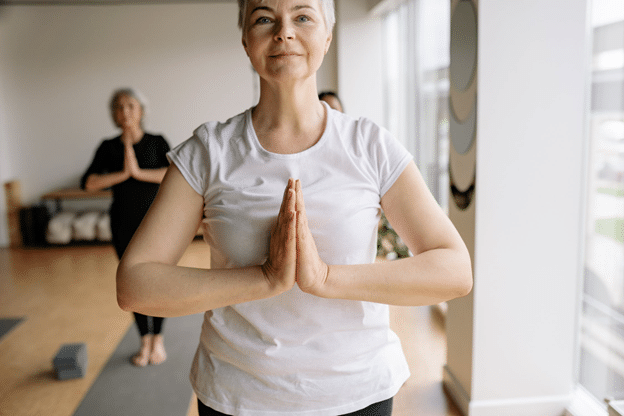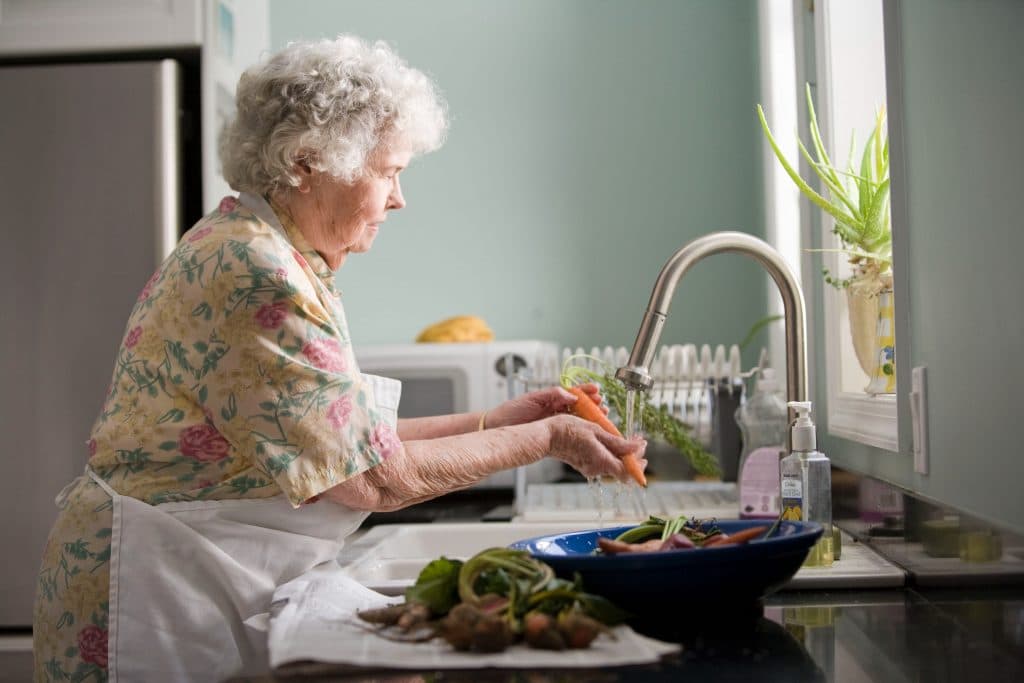Despite what you might believe, yoga’s growing popularity isn’t limited to the young. Older adults are increasingly turning to yoga and meditation to find relief from stress and pain and restore physical function. Yoga and meditation have proven especially valuable for family caregivers, who face physical and mental health challenges that far exceed the norm.

The Challenges of Caregiving
Health problems are often common among family caregivers. Informal caregivers frequently neglect their own health while caring for a loved one. While carrying out their caregiving duties, they often face high levels of stress and find it hard to make time for themselves. Heightened stress is manageable in short spurts, but many caregivers stay in that role for several years. Self-neglect isn’t sustainable in the long-term, and mental and physical health problems frequently emerge. Statistics from the Family Caregiver Alliance show just how serious the caregiver health crisis is.
Caregiving is difficult for the person receiving care as well. Losing independence is painful, and many seniors struggle to cope with the change. This leads to depression, anxiety, and apathy in many chronically ill and disabled seniors. On top of the emotional strain, care recipients must cope with physical limitations, also a stressor.
Why Yoga and Meditation?
Yoga and meditation are highly effective at relieving stress. Practicing yoga requires minimal resources. This makes yoga and meditation ideal for seniors and caregivers. Both face high levels of mental strain, but often lack the money or time for a formal fitness program.
Yoga can be practiced three ways.
- while lying on a yoga mat (If you have trouble getting up and down from the floor, start with one of the other options);
- while seated in a chair or wheelchair;
- or while walking.
No matter what your fitness level or flexibility, yoga will help restore your tranquility. Individuals who practice yoga and meditation feel calmer. They also learn important coping mechanisms that can restore the mind/body connection. Yoga improves physical symptoms by building strength, flexibility, and balance. It may even alleviate chronic pain.
Yoga and meditation have less obvious benefits too, especially for elderly practitioners. Yoga and meditation aid in the release of muscle tension, easing problems like teeth grinding and jaw clenching. This is important for older adults, who are more prone to pain and dysfunction in the temporomandibular joint. By relieving symptoms of stress and depression, yoga and meditation improve seniors’ executive function so they stay on top of self-care habits like dental hygiene.
Yoga and meditation benefit gut health as well. Researchers are still learning how gut health influences the body, but what they do know is this: Gut health affects more than digestion. A healthy gut plays an important role in our sense of well-being. On top of eating a healthy diet, regular exercise and stress management are some of the best ways to improve gut health — and a happy gut, in turn, promotes a sound mind.
Yoga and Meditation Tips for Beginners
Despite their many benefits, yoga and meditation are frequently absent from self-care routines. Caregivers and seniors may believe yoga and meditation are too difficult, or they may simply be unfamiliar with the practice. After all, we did not learn how to practice yoga in our high school physical education classes. However, it’s never too late to learn.
Take Advantage of Your SilverSneakers’ Benefit
Many new practitioners choose to practice yoga and meditation at home. That’s an excellent option, especially for seniors who are homebound. However, beginners to yoga and meditation benefit greatly from instruction, and if you’re a senior, it’s easy to get started. Many Medicare Advantage plans offer seniors eligibility to the SilverSneakers fitness program. This benefit grants seniors membership to gyms and YMCAs around the country.
Even better, however, SilverSneakers has live classes and workouts you can watch from home. Even if you’ve never tried yoga before, this is a perfect place to start.
Tips for Newbies
These tips will help new practitioners get started in yoga and meditation.
- Find a quiet place to practice. Yoga and meditation don’t require a lot of space to practice, but they do call for a distraction-free environment. Designate a room or corner for yoga, clearing out the clutter and decorating with dim lighting, media for music and instructional videos, and yoga equipment. Set up an iPad or laptop so that you can see the screen.
- Make yoga a daily practice. A few minutes of yoga or meditation set a positive tone for each day. Consistency is also the best way to form a habit.
- Use props and adaptations. Balance and alignment are more important than completing a pose exactly as it’s shown in videos and books. Props and adaptive strategies such as chair yoga allow beginners and people with physical limitations to gradually increase their range of motion and avoid injury.
- Remember to breathe. Breath control is central to both yoga and meditation and is key to reaping their stress-relieving benefits.
- Accept that stress is part of life. With all this talk about reducing stress, we sometimes forget that a little stress isn’t necessarily a bad thing–so long as we manage it properly. ZenBusiness points out that a small amount of stress can even be a positive motivation toward creativity and focus, so long as we don’t allow stress to take on a life of its own.



